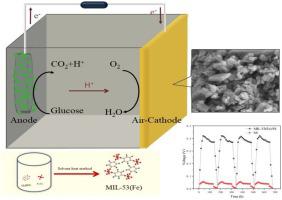当前位置:
X-MOL 学术
›
Process Biochem.
›
论文详情
Our official English website, www.x-mol.net, welcomes your feedback! (Note: you will need to create a separate account there.)
Enhanced bioelectrochemical performance caused by porous metal-organic framework MIL-53(Fe) as the catalyst in microbial fuel cells
Process Biochemistry ( IF 4.4 ) Pub Date : 2020-12-01 , DOI: 10.1016/j.procbio.2020.09.003 Hongying Wang , Liting Jiang , Junfeng Chen , Mengyu Fu , Zhongyu Diao , Huanhuan Liu , Huamin Guo
Process Biochemistry ( IF 4.4 ) Pub Date : 2020-12-01 , DOI: 10.1016/j.procbio.2020.09.003 Hongying Wang , Liting Jiang , Junfeng Chen , Mengyu Fu , Zhongyu Diao , Huanhuan Liu , Huamin Guo

|
Abstract To enhance the oxygen reduction reaction (ORR) activity and power generation capacity of a microbial fuel cell (MFC), MIL-53(Fe) (Fe-based Materials of Institute Lavoisier) as the electrochemical catalyst was synthesized using the hydrothermal method. The catalytic structure and morphology of all materials were comprehensively characterized by Fourier Transform infrared spectrometer (FTIR), X-ray diffraction (XRD), scanning electron microscope (SEM) and energy dispersive spectrometer (EDS). The results show that there were many nanopores on MIL-53(Fe), which improved the electrocatalytic activity. The MIL-53(Fe)-modified air cathode MFC had a voltage output of approximately 0.37 V and maintained that output for one week. The maximum power density was 397 ± 6.3 mW/m2. MIL-53(Fe) was an excellent electrochemical catalyst, significantly enhancing the catalytic oxygen reduction ability and promoting the power output of the MFC. This study provides a method to apply MIL-53(Fe) materials in microbial fuel cells.
中文翻译:

由多孔金属-有机骨架 MIL-53(Fe) 作为微生物燃料电池催化剂引起的生物电化学性能增强
摘要 为了提高微生物燃料电池(MFC)的氧还原反应(ORR)活性和发电能力,采用水热法合成了MIL-53(Fe)(拉瓦锡研究所铁基材料)作为电化学催化剂。采用傅里叶变换红外光谱仪(FTIR)、X射线衍射仪(XRD)、扫描电子显微镜(SEM)和能谱仪(EDS)对所有材料的催化结构和形貌进行了综合表征。结果表明,MIL-53(Fe)上有许多纳米孔,提高了电催化活性。MIL-53(Fe) 改性空气阴极 MFC 的电压输出约为 0.37 V,并保持该输出一周。最大功率密度为 397 ± 6.3 mW/m2。MIL-53(Fe) 是一种优良的电化学催化剂,显着增强催化氧还原能力并促进MFC的功率输出。本研究提供了一种将 MIL-53(Fe) 材料应用于微生物燃料电池的方法。
更新日期:2020-12-01
中文翻译:

由多孔金属-有机骨架 MIL-53(Fe) 作为微生物燃料电池催化剂引起的生物电化学性能增强
摘要 为了提高微生物燃料电池(MFC)的氧还原反应(ORR)活性和发电能力,采用水热法合成了MIL-53(Fe)(拉瓦锡研究所铁基材料)作为电化学催化剂。采用傅里叶变换红外光谱仪(FTIR)、X射线衍射仪(XRD)、扫描电子显微镜(SEM)和能谱仪(EDS)对所有材料的催化结构和形貌进行了综合表征。结果表明,MIL-53(Fe)上有许多纳米孔,提高了电催化活性。MIL-53(Fe) 改性空气阴极 MFC 的电压输出约为 0.37 V,并保持该输出一周。最大功率密度为 397 ± 6.3 mW/m2。MIL-53(Fe) 是一种优良的电化学催化剂,显着增强催化氧还原能力并促进MFC的功率输出。本研究提供了一种将 MIL-53(Fe) 材料应用于微生物燃料电池的方法。



























 京公网安备 11010802027423号
京公网安备 11010802027423号